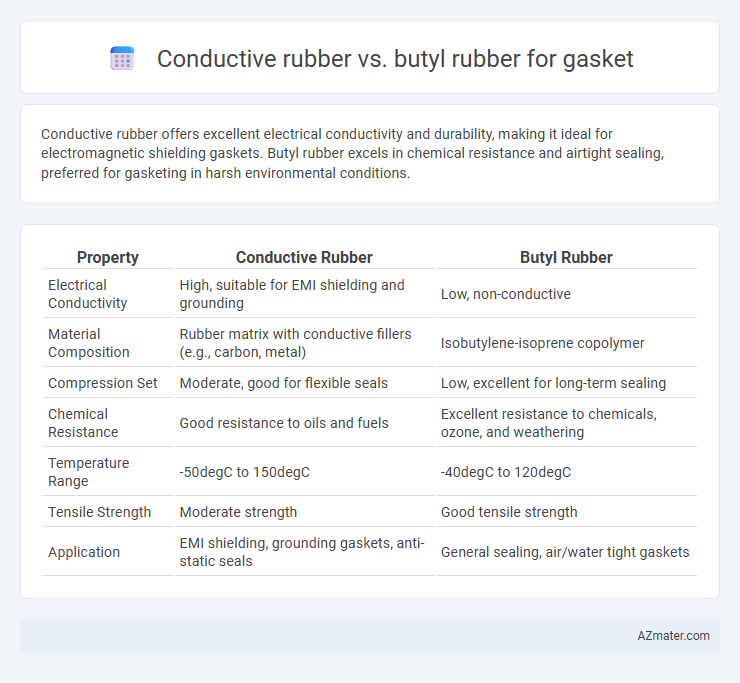Conductive rubber offers excellent electrical conductivity and durability, making it ideal for electromagnetic shielding gaskets. Butyl rubber excels in chemical resistance and airtight sealing, preferred for gasketing in harsh environmental conditions.
Table of Comparison
| Property | Conductive Rubber | Butyl Rubber |
|---|---|---|
| Electrical Conductivity | High, suitable for EMI shielding and grounding | Low, non-conductive |
| Material Composition | Rubber matrix with conductive fillers (e.g., carbon, metal) | Isobutylene-isoprene copolymer |
| Compression Set | Moderate, good for flexible seals | Low, excellent for long-term sealing |
| Chemical Resistance | Good resistance to oils and fuels | Excellent resistance to chemicals, ozone, and weathering |
| Temperature Range | -50degC to 150degC | -40degC to 120degC |
| Tensile Strength | Moderate strength | Good tensile strength |
| Application | EMI shielding, grounding gaskets, anti-static seals | General sealing, air/water tight gaskets |
Introduction to Gasket Materials
Conductive rubber and butyl rubber are essential gasket materials distinguished by their unique properties and applications. Conductive rubber, infused with conductive fillers like carbon or metal particles, offers excellent electrical conductivity and EMI shielding, ideal for electronic and automotive gaskets. Butyl rubber provides superior chemical resistance, impermeability to gases, and excellent sealing performance, making it suitable for automotive, pharmaceutical, and industrial gasketing applications requiring airtight seals.
Overview of Conductive Rubber
Conductive rubber is engineered with carbon black or metal fillers to provide electrical conductivity, making it ideal for EMI shielding and grounding applications in gaskets. Its unique ability to dissipate static electricity while maintaining elasticity ensures reliable sealing under varying environmental conditions. Unlike butyl rubber, conductive rubber combines electrical performance with excellent chemical and weather resistance, enhancing gasket durability in electronic and industrial settings.
Overview of Butyl Rubber
Butyl rubber, a synthetic elastomer derived from isobutylene and isoprene, offers exceptional impermeability to gases, making it ideal for gasket applications requiring airtight seals. Its resistance to heat, chemicals, and weathering enhances durability in automotive, industrial, and HVAC systems. Compared to conductive rubber, butyl rubber provides superior sealing performance but lacks electrical conductivity.
Key Properties Comparison
Conductive rubber offers excellent electrical conductivity and EMI shielding, making it ideal for gaskets in electronic and electrical applications, while butyl rubber excels in chemical resistance, low gas permeability, and superior weathering properties. Conductive rubber typically incorporates fillers like carbon black or metal particles to achieve conductivity, whereas butyl rubber is a copolymer of isobutylene and isoprene known for its flexibility and airtight sealing. Key property differences include conductive rubber's focus on electrical performance and butyl rubber's strength in thermal stability, ozone resistance, and chemical inertness, influencing gasket selection based on environment and function.
Electrical Conductivity Differences
Conductive rubber gaskets incorporate carbon or metal fillers, enabling electrical conductivity essential for EMI shielding and grounding applications. In contrast, butyl rubber lacks inherent conductivity due to its polymer structure, making it ineffective for electrical applications without additional conductive additives. Therefore, conductive rubber is preferred in gaskets requiring reliable electrical pathways, whereas butyl rubber is typically used for sealing and insulation where conductivity is not needed.
Chemical and Environmental Resistance
Conductive rubber gaskets exhibit excellent resistance to oils, fuels, and mild chemicals, making them suitable for applications requiring electrical conductivity and chemical durability. Butyl rubber gaskets offer superior resistance to weathering, ozone, acids, and alkalis, excelling in harsh environmental conditions and outdoor applications. Selecting the appropriate gasket depends on the balance between electrical conductivity needs and resistance to specific chemical and environmental stressors.
Application Suitability
Conductive rubber gaskets excel in electronic and electromagnetic shielding applications due to their ability to conduct electricity and provide effective EMI/RFI protection, making them ideal for connectors and enclosures. Butyl rubber gaskets offer superior chemical resistance, weatherproofing, and low permeability, suited for sealing applications in automotive, HVAC, and waterproofing industries. Selecting between conductive and butyl rubber gaskets depends on whether electrical conductivity or environmental sealing and chemical resistance is the priority in the application.
Cost and Availability
Conductive rubber gaskets generally come at a higher cost due to specialized conductive fillers like carbon black or silver, which enhance electrical conductivity properties. Butyl rubber gaskets are more affordable and widely available because of their simpler formulation and extensive industrial use. Availability of butyl rubber is greater globally, making it the preferred choice for applications prioritizing cost-efficiency and easy procurement.
Performance in Extreme Conditions
Conductive rubber offers superior electrical conductivity and excellent resistance to high temperatures, making it ideal for gaskets in extreme thermal and electrical environments. Butyl rubber provides outstanding chemical resistance and exceptional elasticity, maintaining gasket integrity under harsh chemical exposure and extreme pressure fluctuations. When selecting a gasket material for extreme conditions, conductive rubber excels in applications requiring static dissipation, while butyl rubber ensures long-term sealing performance against aggressive chemicals and wide temperature ranges.
Choosing the Right Rubber for Your Gasket Needs
Conductive rubber offers excellent electrical conductivity and EMI shielding, making it ideal for gaskets in electronic enclosures and applications requiring static dissipation. Butyl rubber excels in chemical resistance, airtight sealing, and durability, suited for automotive, HVAC, and industrial gasket needs where impermeability and flexibility are critical. Selecting the right rubber gasket depends on the specific application requirements such as electrical properties, chemical exposure, and environmental conditions.

Infographic: Conductive rubber vs Butyl rubber for Gasket
 azmater.com
azmater.com